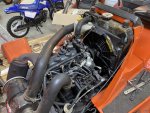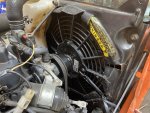I think you would have been better off with a pusher mounted on the other side, but then it would be tough for when debris gets on there. Maybe it could have been adapted to the removable screen somehow
Kubota tractor overheating when fan replaced to electric. (Kubota G1900S (D722))
- Thread starter jacoBiceps
- Start date
dvcochran
Active member
Equipment
Kubota M9000, New Holland TN90, Deere 2640, Vermeer 504N, Vermeer 504SI, more
No such thing as too much air. Now whether or not it is moving the right way is another question. Could you have the fan wired or mounted backwards? Pushing air instead of pulling air? Is the fan shroud effectively disabled (you said you had to bend it?I used a PWM fan speed controller to not have it run at full tilt all the time. Some people said it was moving "too much air".
Post these pictures in the Daily Chuckle thread.Pictures
ve9aa
Well-known member
Equipment
TG1860, BX2380 -backblade, bx2830 snowblower, fel, weight box,pallet forks,etc
That shroud is.........hmm........interesting.
What was wrong with the original fan setup again?
What was wrong with the original fan setup again?
Transverse engine mounting has very little to do with it. Greyhound busses had transverse mounted engines LONG before anyone thought about putting an electric fan on engines. The engine was in the back and the radiator on the driver's side. They used temperature sensitive clutches to control fan speed and flexible blades to keep them from howling. It took some pretty creative belt routing to turn that fan.The other reason modern cars need electric fans is the stupid transverse engine design we've been stuck with for so many years. It ain't right. Engines should face front to back and drive rear wheels
My 2014 F-150 has E-fans on a 5.0L V8. Front-to back crank orientation. 4X4, but normally only use rear wheel drive except for special occasion. Your point is what? I never had a transverse mounted engine overheat, either. Most of my overheating was blown head gaskets or coolant loss, but NEVER has it been airflow.
I had to laugh when I visualized a marketing guy pulling his hair out trying to dream up how to sell a layout like that on a home use passenger vehicle...LOLGreyhound busses had transverse mounted engines LONG before anyone thought about putting an electric fan on engines. The engine was in the back and the radiator on the driver's side.
A family friend was a VW mechanic. He always said that Americans only built two vehicles right. The Greyhound Bus, and the Corvair. Engine (heat and noise) in the back where it should be.I had to laugh when I visualized a marketing guy pulling his hair out trying to dream up how to sell a layout like that on a home use passenger vehicle...LOL
I was thinking more about a radiator point out one side....like the bus does...LOLA family friend was a VW mechanic. He always said that Americans only built two vehicles right. The Greyhound Bus, and the Corvair. Engine (heat and noise) in the back where it should be.
The Greyhog bus also has the radiator on the side. Can you imagine seeing a Camry with the radiator in the passenger side fender  Re, electric fans on say the F150 they're not there as a "must have to fit" they're used to try to eek out an extra mpg or 2. Not because they're necessary or even better.
Re, electric fans on say the F150 they're not there as a "must have to fit" they're used to try to eek out an extra mpg or 2. Not because they're necessary or even better.
I tried that. It was moving tons of heat, because my leg was on the verge of melting. Then again, this isn't the right way.No such thing as too much air. Now whether or not it is moving the right way is another question. Could you have the fan wired or mounted backwards? Pushing air instead of pulling air? Is the fan shroud effectively disabled (you said you had to bend it?
It would get hotter than normal on hot summer days.That shroud is.........hmm........interesting.
What was wrong with the original fan setup again?
No it's most definitely pulling air out the back, the way it originally did.No such thing as too much air. Now whether or not it is moving the right way is another question. Could you have the fan wired or mounted backwards? Pushing air instead of pulling air? Is the fan shroud effectively disabled (you said you had to bend it?
Attachments
-
616.1 KB Views: 182
-
601.1 KB Views: 190
The electric fan pulls roughly 9 amps at 12v at full tilt so roughly 108 watts.What is the wattage of the electric fan at max speed?
Which fan blade angles are more aggressive, belt driven or electric?
For the electric fan, is there any short circuited air flow; ie., through the fan, but not the radiator?
Point of reference for what it's worth: My Chevy Colorado 3.6L DI uses a ~800 watt fan with the alternator capacity to drive it. Diesels produce more heat under load.
Can you measure the electric fan RPM?
* I am assuming belt driven fan does not use a clutch so you can figure out it's RPM.
My take is the belt driven fan provides more airflow.
The belt drive's fan blades are definitely more aggressive as there are only 4 blades instead of 10.
I don't know about short circuited air flow.
I can't measure the rpm of the fans. I would have to get a meter.
I already had that part about the F-150 e-fan in the reply, but it was too long and cut it out. I had a 92 model, same size engine (5.0L), but less than 1/3 the HP this beast has. Lotsa folks put E-fans on the Gen 8 F-150's to get that tiny bit of HP from them because the old speed density systems (in use until 1994) weren't very compatible with performance upgrades such as cams. The point there being, with the HP of that engine, it was a lot more noticeable. Same HP gain on a more powerful engine isn't nearly as noticeable. So, if I boosted HP output with fuel system changes and turbo, will I really notice what the e-fan gives back? Probably not. Kubota knew what they were doing, I'm pretty sure of it.The Greyhog bus also has the radiator on the side. Can you imagine seeing a Camry with the radiator in the passenger side fenderRe, electric fans on say the F150 they're not there as a "must have to fit" they're used to try to eek out an extra mpg or 2. Not because they're necessary or even better.
108 watts of power to fan motor, probably <90 watts moving air. That's just a butterfly wing flap compared to the belt driven fan. Ok, maybe I exaggerate some.The electric fan pulls roughly 9 amps at 12v at full tilt so roughly 108 watts.
The belt drive's fan blades are definitely more aggressive as there are only 4 blades instead of 10.
I don't know about short circuited air flow.
I can't measure the rpm of the fans. I would have to get a meter.
My .02 FWIW...a good bit of airflow is being lost by the way the edge of that fan is covered from the "fan shroud" work you did bending it over to hold the fan in place. Fix that fan shroud the way it was originally and find a better way to mount that fan.
GreensvilleJay
Well-known member
Equipment
BX23-S,57 A-C D-14,58 A-C D-14, 57 A-C D-14,tiller,cults,Millcreek 25G spreader,
Have to agree with the others that the shroud 'rework' needs to be totally redone. No part of the shroud should be in the air flow area. It's possible you've lost 30-50% of the capability of the fan
Hmm..fan only draw 9 amps, though spec says 15. Would need to see the graphs and charts to understand why but if 15 amps is true then fan's running at 60% which isn't good,only 480 CFM IF the graphs are linear ( unlikely...)
Hmm..fan only draw 9 amps, though spec says 15. Would need to see the graphs and charts to understand why but if 15 amps is true then fan's running at 60% which isn't good,only 480 CFM IF the graphs are linear ( unlikely...)
The first civil response I got. Thank you. I will see what happens.My .02 FWIW...a good bit of airflow is being lost by the way the edge of that fan is covered from the "fan shroud" work you did bending it over to hold the fan in place. Fix that fan shroud the way it was originally and find a better way to mount that fan.



